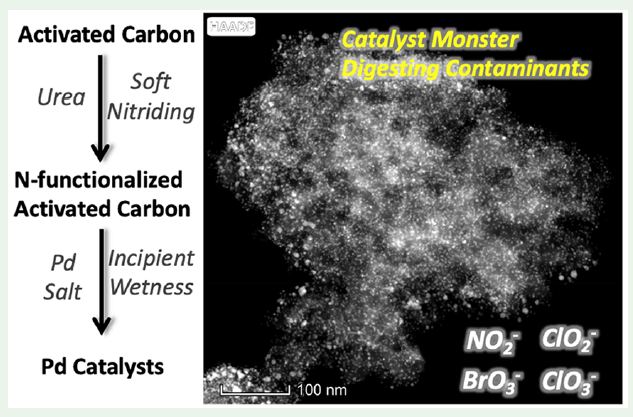Researchers at The George Washington University have developed novel industrially viable catalysts for water purification, catalytic hydrogenation and other engineering application. In addition, an efficient, sustainable, low-cost, and potentially scalable method to tailor activated carbon (AC) supports for Pd-based catalysis with improved performance for water purification has been developed.
Catalyst supports have been found to significantly influence catalytic performance. Metal oxides, for example, Al2O3, SiO2, and TiO2, have been frequently used as catalyst supports. However, the application of metal oxide supports could be problematic because of the dissolution of the supports under acidic or basic conditions. Carbon materials, such as (AC), carbon nanotubes (CNTs), and carbon nanofibers (CNFs) have been demonstrated to be excellent catalyst supports because of their chemical stability during reaction, high surface area and porosity, and adequate mechanical properties. However, the high cost and difficulties of large-scale production limit the application of CNTs and CNFs. Because of its low cost and wide availability, exceptionally high surface area and porosity, and ease of chemical modification, separation, regeneration, and recovery of immobilized noble metals, AC is the most used support for Pd-based catalysts for water purification. The surface modification of AC (e.g., by O or N functional groups) was observed to increase Pd dispersion and optimize the catalytic activity. However, strong acid treatment, high-temperature annealing, or pyrolysis for an extended period of time is required to produce a significant amount of O or N on the carbon.
The GW researchers have provide an efficient, sustainable, low-cost, and potentially scalable method to prepare N-functionalized activated carbon (AC) for Pd-based catalysis with improved performance for water purification. N-functionalized AC supports were realized via “soft nitriding”, that is, low temperature heating of a urea−AC mixture, and Pd nanoparticles with a significantly increased number of surface Pd(0) sites were achieved on the supports. Moreover, Pd nanoparticles were preferentially loaded near the (treated) AC exterior surface. N-functionalization improved nitrite and bromate hydrogenation kinetics but not for chlorite and chlorate, suggesting that different mechanisms determine the reaction activity of these oxyanions.
This technology is a powerful innovation in the water purification technologies, with a large commercial potential in a growing number of environments.

Applications:
1. Water purification
2. Industrial scale production of activated carbon supported Pd for hydrogenation, and other related reactions (e.g., oxidation, coupling reactions)
Advantages:
1. Efficient, sustainable, low-cost, and potentially scalable method to prepare N-functionalized activated carbon (AC) for Pd-based catalysis with improved performance for water purification